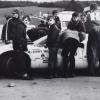Yes, wooden aircraft FTW! I spend some years every Saturday working on a DH9A (PD!) and a Pfalz DXII, woodworking skills, tools and the right timbers were all that was required. Those completed, we moved onto all-metal aircraft, that was a very different proposition.
The one caveat I would place on wooden airframes is the glues used. These need to be carefully selected for the expected environmental conditions, Mosquitos built for the European theatre suffered structural problems in the hot and humid Pacific theatre, and this required a new glue that would handle those conditions.

















